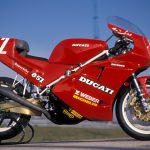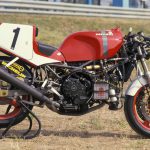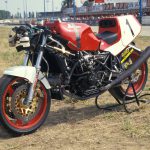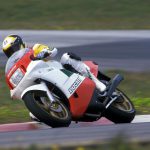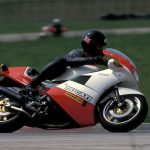Exclusive track test at Misano of the Italian company’s first-ever Superbike racer
Exactly 30 years ago on April 3rd, 1988, the inaugural round of the first-ever World Superbike Championship held at Britain’s Donington Park ended with an upset. Against all expectations, the only twin-cylinder bike on the grid, Marco Lucchinelli's factory Ducati 851 desmoquattro, swept to overall victory, defeating its four-cylinder rivals against which the Italian V-twin had been viewed simply as a makeweight. Lucchinelli placed second in the first of the two races that day to the works Bimota YB4EI-R of Davide Tardozzi – ironically, today’s works Ducati MotoGP team manager! – then won the second when Tardozzi crashed on the final lap trying to pass the Ducati for a double-up win. This handed victory to the Italian V-twin in the combined results – the first and only time this happened in a World Superbike round, with each race henceforward scored quite separately, as today. For the Bologna firm it was a success on a par with Ducati’s other great moments on road racing’s world stage, like Paul Smart’s upset win in the 1972 Imola 200, and Mike Hailwood’s legendary comeback victory in the 1978 Isle of Man TT, exactly ten years earlier than Lucky’s Donington dominance.
First-ever desmo V-twin to employ watercooling, four-valve cylinder heads, twin overhead camshafts, fuel injection and six-speed gearbox, all later adopted across Ducati’s entire model range
On each of those two earlier occasions, nobody had expected the lusty, slower-revving, road-based desmo V-twins to have the measure of the more powerful four-cylinder Japanese bikes – and it was the same at Donington, even with the all-new high-tech fuel-injected desmoquattro that was the grandaddy of the eight-valve desmo V-twins which went on to win 14 World Superbike titles between 1990 and 2017. But Ducati’s triumph proved that with the extra performance offered by the company’s trademark desmo cylinder head design, a European V-twin could indeed be competitive at World level, even in large capacity four-stroke racing where Japanese engines had by then become so dominant. The extra dimension to the inaugural World Superbike Championship offered by the twin’s unexpected performance was a key factor in making the series such an immediate and enduring success. So, too, was the struggle for supremacy between riders such as Tardozzi who’d mostly spent their whole career in Superbike racing, and ex-500GP World champion Lucchinelli who, like Biaggi, Checa, Melandri and others later, had crossed over from the rival Grand Prix circus.

I’d followed the development of the desmoquattro Ducati from the hot seat, by riding Lucchinelli’s 1987 Daytona ProTwins-winning 8V/851 prototype, and the customer 851S which followed. So the prospect of a dozen laps of Misano on Marco’s factory 851 Superbike, which he eventually took to fifth place in the final points standings of what was very much a development season leading in due course to those 14 World Superbike titles for the Italian manufacturer, promised to be a thrill. Moreover, my ride offered a foretaste of the Promised Land – for a year previously, I’d actually bought the first ever customer desmoquattro to be delivered, in order to go racing with it at Daytona and in European BoTT events. But frustratingly, I hadn’t actually raced it yet – the customer 851S Kit wasn’t yet as competitive as a well-honed air-cooled desmodue Ducati F1 Pantah, so I ended up campaigning one of those instead in ProTwins racing, the Aussie-built ex-Kevin Magee Bob Brown bike, and getting up the nose of other desmoquattro customers by consistently beating them with it. So, the prospect of an outing on Marco’s factory Superbike was doubly enticing….

I listened while factory tester Baldessare Monti warmed the tyres for me with a few hot laps on a cold Misano winter day, with the mercury pushing hard to register 5ºC. From trackside, the Ducati sounded like a very loud, high-revving version of a traditional V-twin, presumably higher-pitched because of the extra revs. It didn’t have the rather hollow exhaust note from its D-Day at Donington, when Ducati had experimented with aluminium exhaust pipes to try to slash weight while satisfying the noise meter – and noise limits were much higher then than nowadays. But trading places with Monti for a spell in the hot seat had me convinced I was riding a cross between a four-cylinder GP two-stroke like Randy Mamola’s 500cc Cagiva of the era, and a small-capacity racing car engine. The Ducati was completely unlike any twin I’d ever ridden before – compared to one of those, it didn’t grunt, didn’t thunder, and didn’t even bellow. It just HOWLED!
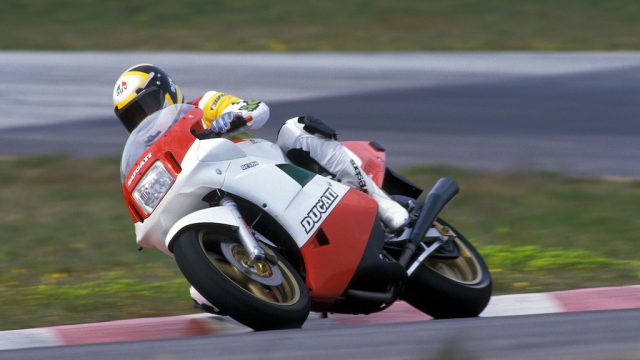
After tiptoeing aboard what was quite a tall bike, I tried to make friends with Marco’s ultra-distinctive close-coupled riding position, which shoved me forward against the tank, and my body weight onto the front wheel, with the aid of a fat rubber bum-pad glued to the seat, then slotted bottom gear and – held on tight! When I cracked the throttle open, the front wheel pointed skywards as I vainly tried to step on the back brake hard enough to keep it on the deck, accompanied by massive induction roar from the twin throttle bodies housed in a primitive airbox. For the rider this completely dwarfed the exhaust note, especially when wound wide open down the Misano back straight. The intake noise came about because the underside of the front of the fuel tank had been lifted, and hollowed out to improve airflow to the intake trumpets.

This improbable feel for a V-twin engine was matched by the way the needle scooted round the black-faced Veglia tacho, aiding that subconscious impression of riding a two-stroke rather than a lusty four-stroke V-twin. And although the fast-revving Ducati pulled hard from around 6,000 rpm, there wasn’t nearly as much torque as I'd come to expect from a twin, so you had to really make the engine sing (or, rather, howl!) to access that high end horsepower, aided by vigorous use of the six-speed gearbox to keep it on the boil.

It was only from 8,500 rpm upwards that the V-twin motor really came alive, so with an 11,000 rpm rev-limiter you needed every one of those six gearbox ratios to keep the Ducati in the powerband. But what a performance by the standards of any V-twin built up till then! Wheelies were an ever-present factor, thanks to the big hit of torque in the bottom three gears once you wound the throttle open, and top end power was strong, too, by the standards of the day, with 125 bhp on tap at the rear wheel at 10,500 rpm, according to Ducati’s engine guru Franco Farnè. Compare that to the 194 bhp produced almost 20 years on by Troy Bayliss’s World champion F06 Ducati 999, with such a wide spread of power from 6,000 rpm up to its 12,500 rpm rev ceiling that it was often geared to use just five speeds in the gearbox for a given track, and you can appreciate the benefits of the intervening two decades of dedicated R&D by Ducati’s race engineers.
The most significant motorcycle engine design of the past 30 years produced by any European manufacturer, as well as the most successful in competition
But this performance from a V-twin desmo back in 1988 was simply staggering, and the way Marco’s bike just rocketed forward once you’d dialled in what seemed back then to be an improbably high five-figure revband for a big V-twin, was both thrilling and astonishing. That was helped by the 2mm overbore on the 94 x 64 mm 888cc engine compared to the start of the season, to squeeze a little extra capacity from the 851cc stock dimensions – but without taking full advantage of the 1000cc capacity ceiling for twins, compared then to 750cc fours. But, as ultra-impressive as the Ducati’s performance was, it wasn’t really that nice to ride – exhilarating, yes, but agreeable, no. The engine felt very harsh and raw-edged – it rasped rather than growled, and you had to use the gearbox a lot to keep it revving hard. And while the 888cc motor certainly didn’t vibrate any more than previous 90-degree desmo V-twins, the legendary Ducati smoothness mostly apparent in their Superbike racers since then, was absent. It felt rather primitive, a far cry from what came later.

No doubt this was the downside of the early development needed to make a twin competitive with fours in Superbike racing, but it was a disappointment all the same. So too were some aspects of the Ducati’s handling. To start with, it weaved insistently when pinned wide open down the Misano main straight, a trait I put down to the same lack of weight on the front end which made wheelies ever-present, and was surely also responsible for Marco’s contrived forward-control riding position. Back then, Ducati claimed a 50/50 weight distribution, but we now know the bike in fact had a rearwards weight bias which compromised handling for some years, till the 1994 debut of the 916 eventually addressed this after its creator Massimo Tamburini had added an extra 25mm/one inch to the swingarm to throw more weight on to the front wheel. And the four-cam L-twin engine layout meant it was quite tall as well as long, so weight transfer under the sudden hit of strong power unloaded the front end. But the Marzocchi rear shock with its distinctive rocker-arm link worked pretty good for back then, laying the power down well via the rear Michelin radial – then a new breed of race tyre compared to the established crossplies – helped by an alloy swingarm beefed up with a sheeted-in brace on the underside.

But, however improbably, the supposedly slimmer V-twin Ducati wasn’t as agile and fast-steering as the bike it had shared victory with on its Donington debut, Tardozzi’s four-cylinder Yamaha-engined Bimota YB4EIR that I’d coincidentally been riding earlier that same winter day at Misano – albeit as a test rider for the small Italian factory on their home track, rather than a journalist. There wasn’t much feedback from the Ducati’s front Michelin crossply, though to be fair the team were testing Marzocchi’s then-experimental upside-down forks, something else like the radial tyres we take for granted now, which at the time were still being developed. These damped OK over bumps, but contributed to the Ducati’s dead feel under braking and on turn-in. They’d dive a good way initially, then freeze up, depriving the big 320mm Brembo front discs and their four-pot calipers of a lot of feel, though these stopped the bike well, again by the standards of the day.
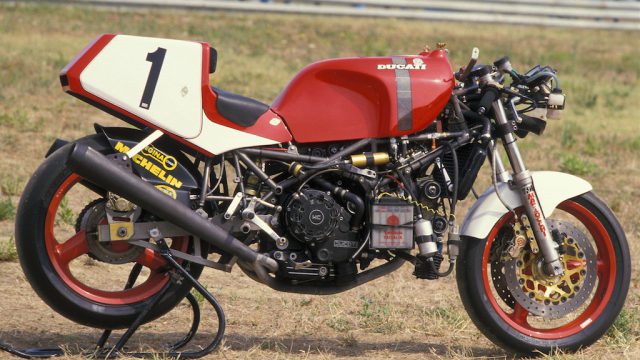
But there was no slipper clutch, so you had to be careful with engine braking via the lusty V-twin motor, and not to use too many revs on the overrun, else you’d get the rear wheel chattering into slower turns. The steering didn’t feel that positive either, with the Ducati tending to flop slightly uncontrollably into corners like the long left-hand horseshoe at the end of the main straight, instead of laying in progressively and easily as the better-handling, more refined-seeming Bimota did And although the Ducati held a line well under power around Misano's several fast sweepers, it wasn’t as happy in slower turns on part-throttle or off the gas, like at the final hairpin before the startline.

But the desmoquattro V-twin had one potentially vital edge against its four-cylinder rivals: fewer kilos. The weight limit differential in force back then required twins to scale a mere 140kg against 165kg for fours – a huge advantage which, together with the engine capacity trade-off, underlined how dismissive the rule-makers were back then of a twin’s chances of running at the front. It took a while for Ducati to start taking full advantage of that, for Lucchinelli’s 888cc Donington race winner could have measured 999cc, which it might have done had its desmoquattro engine not employed crankcases designed for a 600cc air-cooled Pantah, and weighed a porky 162kg dry – not that much of an advantage over the fours, but one that would really start to make a difference once the kilos came off, as they did in later years.

But what really counted back then was the Ducati’s phenomenal twin-cylinder engine performance against its four-cylinder opposition, and the 851 Superbike’s Donington race debut back in April 1988 could be summed up in one word – impressive. It was the opening salvo in an R&D campaign which took just two years for Raymond Roche to score the first of Ducati’s 14 World Superbike titles in 1990, as the start of a long run on centre stage that’s still continuing today – and will do for just one more season until the Bike That Made Ducati Famous is replaced by the V4 Panigale R on Superbike race grids from 2019 onwards.
You can also read: 2018 Triumph Speed Triple price announced

